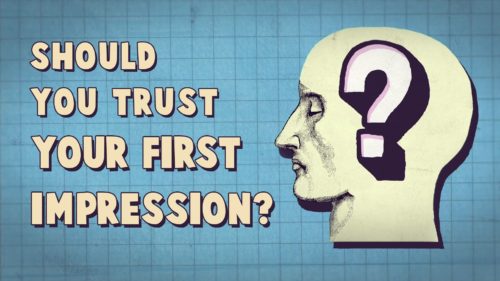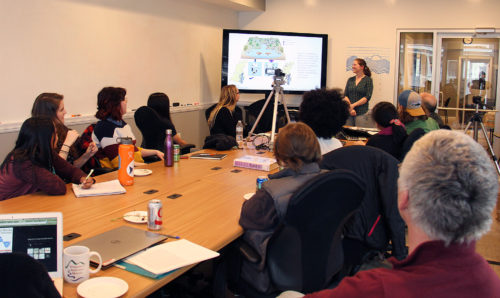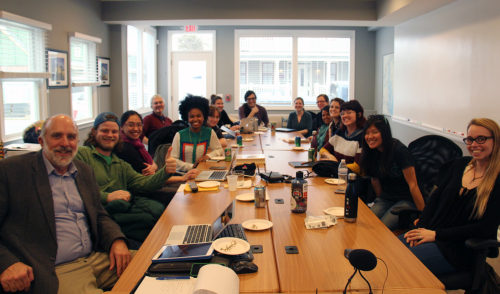Countdown to elevator pitch 3…2…1 “GO”
Wilmelie Cruz Marrero ·Wilmelie Cruz Marrero
Imagine you are running to an elevator when you suddenly realize the top expert in your field is there. How can you catch her/his attention? How can you compress all of your knowledge and effectively communicate your research? What about a 3 minute elevator pitch? How can we reduce our 320 some page thesis into a 3 minute pitch!? Well . It's pretty hard!! That's what students in MEES Coupled human and natural systems completed this week.

We had to change the way we communicated science in order to be successful. We had two options for our presentation: 1) Follow the narrative story telling method (practical; place based) or 2) the logical science communication method (theoretical; not place based). Most of us instinctually follow the logical science communication method because is the technique we are most comfortable with.
Elevator speeches follow these basic rules: Identify your goals, explain what you do, communicate the importance, engage your audience, and practice (Management Training and leadership training, Online). We followed these rules and added Randy Olson's AND, BUT, THEREFORE or ABTS storytelling technique found in his book "Houston, We Have a Narrative." This technique enhances the story and removes the scientific jargon by adding tension and giving a punch to our usual speeches while obligating us to think outside the box and include these 3 words in our speeches.
Video of the book "Houston, we have a narrative" showing how the AND BUT THEREFORE narrative fix some of the usual scientific jargon and let our story flow. Source: https://youtu.be/rkAM9noWjFk
Our story telling begins with our title. It is the first impression, it creates anticipation, and expectation. It has to call attention and it must be less than 140 characters long and include keywords to entice the audience. Titles need to be short and sweet (e.g. "Assessing cultural and natural resources: Report cards" vs. "Report cards aren't just for school anymore"). We quickly learned from constructive feedback that acronyms are not welcome in our titles, speeches, and abstracts. Terms that are not well defined should also not be included in the title. If these terms are necessary or represent our techniques, we would add keywords that lead to a definition. (e.g In Krystal's title, the use of term "Emergy" with other words like "holistic" and "alternative", will guide the audience to its definition).

During the speeches we used techniques to connect with our audiences. Alec used a metaphor, I used Maryland crab cakes to relate to queen conch fritters in the Caribbean, and Veronika used Ernst Götsch as a hero to promote sustainable agricultural practices. All of these are good techniques to captivate the audience and successfully transmit a message. As we proceeded through our speeches we discovered that the AND, BUT, THEREFORE template was needed to create a good flow and connect with our audience. It also brought precision and compliance to our speeches. Each of these words brings an essential element to our elevator pitch.
Let us discuss how the AND, BUT, THEREFORE method works. The word AND creates a link but the overuse of it also leads to boring speech, when you add BUT in the middle it works as a STOP and creates a pause, and THEREFORE tells our solution and our discoveries. Adding a graph can tell a story for you, they summarize information in a way that is easy to understand. Both techniques combined lead to successful presentation of information and alleviate some of our public speaking nightmares.

When it came time to actually present our "elevator pitch" most of us were shaking, had raspy voices, and were nervous wrecks to confront "the top expert in our fields." We are scientists, not natural public speakers. The added pressure of being filmed and presenting to our peers and professors did not alleviate any stress. Some of us used the old fashion "imagine your class naked" method, but that it did not work! Getting out of our scientific formats was a much harder task than we expected. Some of us tried memorizing our speech word for word. We found that this can backfire. Attempting to memorize the speech word for word can really throw off your concentration and force you to lose your train of thought when you get off script. This happened to me, fortunately I found that the best option to regain composure was to take a deep breath and bring my focus back to where I wanted to take the audience.
I think it was a relief to all of us when we could take a nice deep breath after we completed our presentation. We then received feedback from our peers and professors that we were so anxious to speak in front of. This was beneficial to all of us, so that we can learn from everyone's styles and mistakes.

Overall this activity was a challenge for all of us, AND made us realized that public speaking is a challenge especially when trying to communicate our story with people of different backgrounds, BUT the AND, BUT, THEREFORE method is a good story telling technique that helped us create engaging communication for audiences of different backgrounds, THEREFORE we were successful!

References:
- Developing scientific narratives lecture. Bill Dennison 2017. MEES 620 Coupled Human & Natural Systems.
- Management Training and leadership training, online. Visited: March 2017:
- Olson, Randy 2015. Houston, We Have A Narrative: Why Science Needs Story. ISBN 9780226270708.
Additional information on Ernst Götsch:
Next Post > Co-development of the Belmont Forum synthesis document
Comments
-
Natalie Yee 7 years ago
I think another component that rakes up nerves when it comes to an elevator speech is that it is just that: a speech, not a dialog. Should the head honcho of the expert be in our presence for only a short amount of time, of course you want to put an impressive amount of knowledge while not being overwhelming. The expert may not be able to fully take in every small detail of your project, so anything that makes it easier to understand or more relatable is essential. We saw this with the use of analogies and stories.
It can be difficult to pick out the backbone essentials of our project, but I feel that once we feel comfortable enough with delivering "elevator speech", it will be much easier to explain not only to a scientific community but with anyone. It does not have to be a memorized script, but deeply understanding the few critical points you intend on expanding upon will help us truly have an understanding of what the take home message is for our project.
-
Rachel E 7 years ago
I really loved the ABT you put in the last paragraph! That was a clever ending .i agree with the comments above. I always try to memorize the facts and statistics that I think are noteworthy for a presentation but sometimes theses "geeky" facts are not what the audience wants to hear. Thinks exercise was important to help show me (1) I need to practice an elevator schpeal if I ever am to meet an expert (2) knowing your audience is really important.
Great blog!!! -
Killian F 7 years ago
I agree with the others that trying to memorize a sort of script for the elevator speech was where a lot of us had trouble. My speech was a lot like my abstract, and I had planned a logical progression of points. I ran into trouble when presenting when I realized I had skipped an important point that 'belonged' when I was talking about one topic (GOES-R) and then had trouble trying to fit that point back in when I had moved onto a different section (supercell climatologies). Like Suzi said, even though both the abstract and elevator speech should have ABTs, there should have been more differences between my abstract and speech so that my speech would have more flexibility. I think this class taught us all valuable lessons, and Wilmelie did a good job summarizing our class.
-
V Leitold 7 years ago
I agree with the suggestion of treating the elevator speech separately from the written abstract; while both can effectively incorporate the ABT structure, each of them requires a different kind of vocabulary and probably different sentence structures too. I think that the elevator speech is more effective if it is communicated in short sentences and minimal technical language so that a non-expert can easily follow it, while compound sentences and more complicated words are better suited for a written abstract, where one can spend more time reading the text, if necessary for understanding. Also, I often find that it is easier for the audience to understand and retain the speaker’s message if there is a link in the speech to something we all experience in our everyday lives, or a personal anecdote that makes the speaker and her topic more relatable.
-
Kelly Hondula 7 years ago
The similarities and differences between the abstract, elevator speech, and graphic also resounded with me. Having components of all 3 versions in mind can probably help adapt to a particular communication. A powerful metaphor or diagram will go a long way in most situations. A few other comments brought up the differences between a one-sided speech vs a dialog, where you can respond to particular subjects that might pique the interest or curiosity of who you are talking to and capitalize on those aspects to make your point.
-
David Miles 7 years ago
I actually prepared differently, it seems, than most people in class. I wrote my ABT excerpt carefully and knew its concepts fully. I then thought of key points I'd like to make outside of the ABT summary. I didn't really have a script at all, I figured I'd wing it.... Then as the moment approached I got nervous and started frantically writing on my hand all the things I should say so I wouldn't forget. In the end the notes on my hand backfired, and didn't help me at all. They actually just threw me off knowing they were there. I think, for me anyway, I know enough about my topic that can can speak freely on it as long as I have the ABT way-points to go off of. In the end I should have stuck to my original plan.
-
Noelle O. 7 years ago
I, too, feel like I would prepare differently if I had the chance of redoing an elevator speech. Despite recently presenting a poster at a conference where I had to repeat my story over and over, I still felt like I cracked under the pressure of the camera and in front of my classmates. I didn't realize how quickly three minutes would pass, and that switching up my words on-the-fly didn't really work in my favor.
This exercise, although terrifying, did provide valuable insight. I learned where I could better express the "but"/drama portion of my ABT, and even applied these tips to an abstract that I submitted for a future conference.
-
Krystal Yhap 7 years ago
I agree with Suzi. A lot of us tried to memorize an abundance of information, thinking that memorizing the information would allow us to be able to convey our projects effectively even if we got nervous. I noticed with most of us that tried to go this route (including myself) that the memorized script came out okay for the first couple sentences but inevitably we each had a mental gap happen where we forgot some part of our memorized speech, or skipped over portions we wanted to say. I found when I took a short moment to pause and think about my "and, but, therefore.." statement it helped me to get back on track to what was most important to get across to the class as my audience. The ABT framework was able to help me refocus when I got lost during my elevator speech. This exercise taught me how the ABT framework can be used effectively but I also noticed that for some it did not come as naturally or serve as effectively for conveying their project content. I also realized how much more engaged I was when people used the story telling method (like Veronika) or a relate-able anecdote (like Wilmelie ) during their elevator speeches. Treating an elevator speech more like a conversation rather than a memorized scientific presentation (of course depending on your target audience) proved to be a more effective approach that allowed you not only to convey your point effectively but present your work in a memorable way as well. I felt if I had tried to describe my research in a way that was more story oriented then I would have been able to be more relaxed during my elevator speech and I would have been able to present my information more fluidly without large memory gaps. Like Suzi said, if I had to do it over again I would have crafted my elevator speech separately from my abstract because I do feel they are two different things and should remain that way. Wilmelie did a great job capturing the challenges we faced during last week and understanding the purpose of ABT and I love that she ended the blog with an ABT statement!
-
Rebecca Wenker 7 years ago
Good blog, Wilmelie! Like you mentioned, there's just something about public speaking that can really drive fear into the heart, even if it's just a 3 minute elevator speech! As Suzi mentioned, trying to memorize a carefully crafted abstract to present to your audience could be problematic, especially if your audience changes. It depends on who you are speaking to, and you must be able to shift your elevator speech accordingly. I guess I would suggest knowing how to frame the ABT format to your specific research, and being able to add additional details as necessary (if appropriate to the audience).
-
W.Cruz 7 years ago
I agree with Suzi. Part of the difficulties in this scenario was our audience and using and, but, therefore did not come as natural to me. I had to memorize using therefore because it did not flow in mind.Then I stumble, in my opinion it is part of how academia train us to be and it is very difficult to think outside of our boxes.
-
Suzanne Spitzer 7 years ago
I think a problem that most of us faced when giving our elevator pitch was that we essentially tried to present our meticulously-crafted ABT scientific abstracts by memory, instead of approaching the oral assignment as a separate task altogether. Both the elevator speech and the abstract should follow the ABT format to introduce the story of the research, but besides that commonality, elevator speeches are totally different. I found this interesting article (below) that touches on the distinction between the two. It says “You don't want to give them your abstract… Instead, think about what you might write in the discussion section of a paper.”
My audience in the elevator is one or two people who I want to connect with for a specific reason, rather than a broader readership. What would I say, in a few sentences, to a person in an elevator in order to engage them and get them interested in me or my research? If I had the chance to do this assignment again, I would craft my elevator speech before writing my abstract so they could remain distinct in my head, and I would also pick a specific imaginary elevator companion to target my conversation to so I would have a particular goal in mind.
http://www.apa.org/gradpsych/2010/03/cover-elevator-speeches.aspx